Evaluating Potential of Organic Tomatoes in Colombia: Economic and Social Opportunities
Info: 6024 words (24 pages) Dissertation
Published: 9th Dec 2019
Organic tomatoes. Evaluating the potential in the region Catatumbo, Colombia
Introduction
In the 21st century, the world is facing serious environmental, social and economic problems. These also present us with opportunities for positive change. In the rural areas of Colombia, many families live in abject poverty and a state of uncertainty. They face numerous social, political, and economic challenges, which can make their lives difficult. The prevalence of these problems demands immediate action to instigate change, especially in the Catatumbo region. As well as poverty, environmental degradation is a significant problem in the region. The local environment is impacted by deforestation and pollution from agricultural inputs such as synthetic fertilizers and pesticides. Poor management of forests and farmlands has reduced the value of natural resources.
Farming tomatoes in the region of Catatumbo is a significant component of economy. Organic farming initiatives offer the potential to counteract the harmful current practices. Organic Agriculture (OA) is a system that links the whole ecosystem and people, using local available renewable resources, sustaining the health of soils and biodiversity in a holistic process. Farming tomatoes organically can boost the health of the ecosystem and the well-being of the society but also the economy of the area.
This briefing paper addresses the potential advantages of organic tomato farming in Catatumbo, the opportunity it offers for economic and social development, and the challenges for further development. It aims to inform governments and policy makers of the potential impact of OA, specifically tomato farming, in Catatumbo, and to identify key issues for implementation. It summarizes research findings on the situation in Catatumbo, the benefits of OA, Organic market trends and the region current stage, then provides conclusions, and recommendations for the future development of organic farming.
About Catatumbo
The Catatumbo region is located in the state of Norte de Santander in the north-eastern part of Colombia. It borders Venezuela to the east and north. It is strategically located with proximity to an international border and connections to both northern and central areas of the country (OEA/MAP, 2016). Catatumbo constitutes almost 50% of the state’s entire territory, and is made up by 11 municipalities with similar social, economic, geographic and cultural characteristics. Additionally, the region possesses precious natural resources and is extremely rich in biodiversity (CONPES, 2013).
Despite these apparent regional advantages, people living in Catatumbo experience high poverty levels, high unemployment and poor educational outcomes. Education and health services are poor and many students drop out of school. Critical economic infrastructure (roads and other transport facilities) is also lacking. These factors have resulted in particular conditions of vulnerability for the region’s inhabitants. Furthermore, this area faces a history of many years of armed conflict that are directly related to illicit crops – more specifically the coca cultivation, which currently is an important income source for many of the families in the rural areas of this state (OEA/MAP, 2016).
Even though the region is known for producing illicit crops, some farmers have placed their hope in alternative crops like tomatoes. Tomato farming in the area is significant. In 2017, 27% of Colombia’s tomato production[1] came from Catatumbo, mostly to supply the domestic market. This represents a substantial component of the local economy, generating valuable income for Catatumbo farmers, but it is also impacting the environment. Catatumbo’s tomato farmers use unsustainable agricultural practices, and the quality and quantity of arable land in the region is declining due to the overuse of pesticides.
In Colombia, 499.4 kg of chemical fertilizer is applied for each hectare cultivated, while the average in Latin America is 106.9 kg (Uribe, 2013). Furthermore, poisoning from agricultural chemicals is the second most common reason for people in Colombia requiring emergency care (Unimedios, 2015). Mancozeb, a fungicide used for crops such as tomatoes, has been found to have deleterious effects on human health and on the environment. Indeed, its extensive use has raised the issue of possible health risks for agrarian communities (Anna Virginia Adriana Pirozzi, 2016). Studies reveal that 99% of pesticide fatalities occur in developing countries, in rural populations where poverty is widespread, literacy levels are low and farmers have very little understanding of the safety protocols for using chemical pesticides (Kesavachandran, 2009). Poor farmers are usually more vulnerable to the impacts of environmental degradation as they depend on the land for their livelihood. Any environmental degradation in Catatumbo, will reduce farming incomes, and lead farmers to deplete their natural resources even more. A circle of resource depletion is becomes inevitable (Setboonsarng, 2006)
Conventional agriculture has allowed farmers to fulfil their immediate needs at the cost of environmental degradation, thus threatening the sustainability of agriculture itself as well as the health of people consuming its products (Golam Rasul, 2004). In order to address all these issues many researchers have considered low external input sustainable agriculture, particularly organic farming as the most sustainable way (Zeynab Jouzi, 2016)
Why organic agriculture?
OA protects the earth, sustaining the health of the soil, ecosystems and people. According with the FAO, organic agriculture fosters biodiversity that is relatively resilient to the impacts of climate change (Scialabba & Hattam, 2003). It relies on local renewable resources and biodiversity, and it sustains local ecosystems by tapping into local knowledge. OA uses natural inputs and special practices, such as crop rotation, and prohibits the use of pesticides, synthetic fertilizers, and genetically modified seeds, as well as preservatives and additives (Javier Sánchez Castañeda, 2017). OA is developed in a holistic system where inputs and outputs are harmless for the environment. OA practices and local innovations can lead to increased food security and farm incomes (FAO, 2013).
According with Zeinab (2016), organic farming develops a higher resilience to environmental change, increases farmers’ incomes[2], and reduces external input costs, enhancing social capacity, increasing employment opportunities, and enhancing food security. However, there are a number of challenges to introduction of OA including lower yields, difficulties with soil nutrients[3], certification and market barriers (Zeynab Jouzi, 2016). A study carried out by FIDA (2003) reviewed the experiences of producers in Mexico, Guatemala, El Salvador, Costa Rica, Dominican Republic and Argentina and found the adoption of organic production in most cases increased the income of producers. While some research has found that organic cropping systems are more profitable than conventional systems, other studies have revealed that returns from organic farm management are equal to, or less cost-effective than conventional management (K. Surekha, 2013). However, there is a growing demand for organically produced foods worldwide and many international and national organizations are taking greater interest in organic farming research (K. Surekha, 2013).
OA, as defined by the International Federation of Organic Agriculture Movements (IFOAM) is based on the four basic principles of health, ecology, fairness and care of humans as well as ecosystems. According to the proposed Codex definition, “organic agriculture is a holistic production management system which promotes and enhances agro-ecosystem health, including biodiversity, biological cycles, and soil biological activity” (FAO, 1998). Need page reference for a direct quote. Improvements in biodiversity due to OA have been confirmed by research studies (Rahmann, 2011).
Agriculture’s potential contribution to the Sustainable Development Goals (SDGs) has been widely recognized (Setboonsarng, 2006). While agriculture is generally seen to be important in contributing specifically to SDG 1: End poverty in all forms everywhere and SDG 2 End hunger, achieve food security and improve nutrition, and promote sustainable agriculture. Evidence suggests that OA contributes to the seventeen SDGs (Gregorio, 2017).
Organic Agriculture Market
The market for organic agricultural produce reached around 89.7 billion dollars last year, increasing by 50 % from 2010 to 2017 (Cain, 2018). Consumer demand is currently growing faster than supply, and today 2.7 million producers from 178 different countries (2.4 from developing countries) has OA systems in place[4] (Willer, 2017, Lernoud, 2018). Only 1.1% of the agricultural land is organic (Fig 2, Willer 2017) (Willer, 2017) and almost half of the world’s organically farmed land is in the Oceania region (Fig 1). People are aware of the risks associated with agrochemicals and they are demanding a premium and healthy product that does not harm the environment (FIDA , 2003). The growing interest in consuming organic products is also part of a global trend of changing values, based on a greater concern for quality of life, the environment and society, self-realization, democracy, etc. A study in -Brazil suggests that values regarding security, universalism and benevolence are the most important for consumers (Santos Neto, 2017).
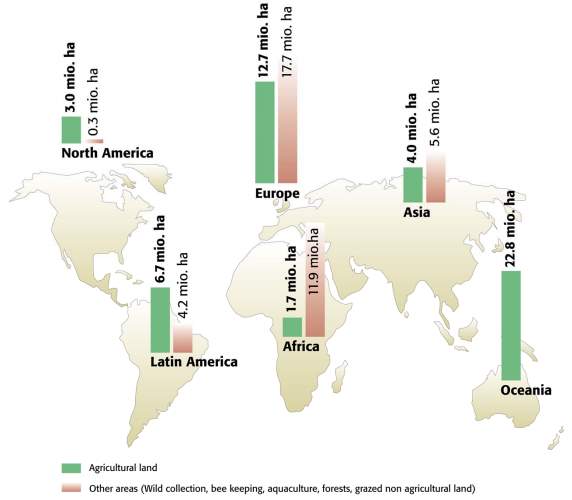
Fig. 1 World: Organic agricultural land and other organic areas 2015. Source: Research Institute of Organic Agriculture (FiBL) and International Federation of Organic Agriculture Movements IFOAM-Organic International World of Organic Agriculture Yearbook 2017.
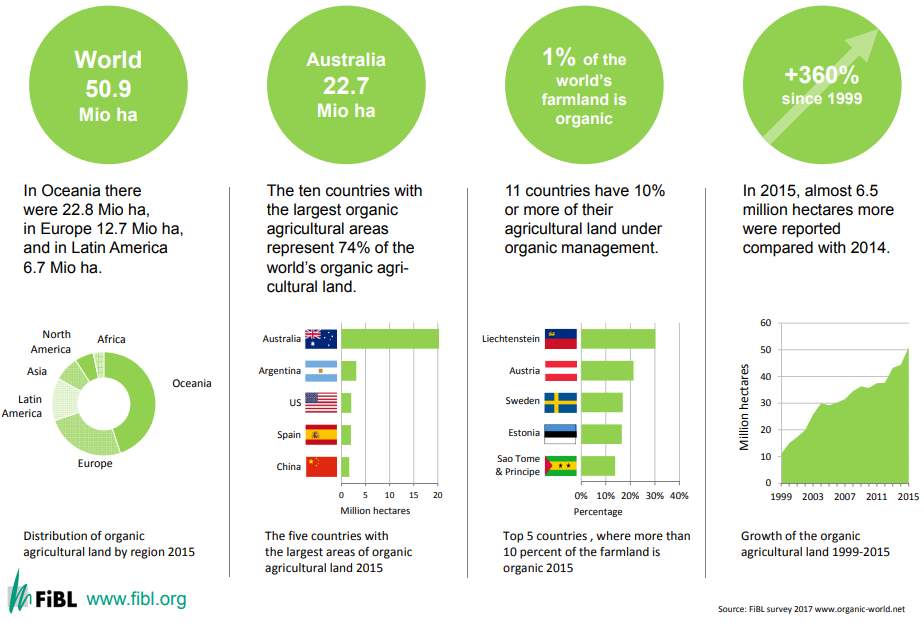
Fig.2 World Organic Farm land 2015. Source: Research Institute of Organic Agriculture (FiBL) and International Federation of Organic Agriculture Movements IFOAM-Organic International World of Organic Agriculture Yearbook 2017.
Organic agriculture in Colombia.
Organic farming is not new to the Colombian agriculture community. Several forms of organic farming are practiced around the country and Colombia has many different organic crops such as coffee, bananas and palm oil (Javier Sánchez Castañeda, 2017). With a great variety of climates and plenty of land agriculture contributes significantly to the Colombian economy. Despite a downturn due to the global economic crisis in 2008, land use for OA in Colombia has remained relatively constant (31 621 ha) over the years (FiBL, 2018).
Initiatives from the Ministry of Agriculture and Rural Development in Colombia have provided a normative framework for organic agricultural production, documented in Resolution 0187 of 2006. Even so, challenges for promotion of OA remain and these need to be addressed collaboratively, across institutions (Javier Sánchez Castañeda, 2017). On the other hand, the development business has not generated enough favourable spaces to strengthen this type of agricultural systems and their understanding has not yet been sufficiently huge potential (Martínez Bernal, Bello Rodríguez, & Castellanos Domínguez, 2012).
Currently, The Colombia Institute of Agriculture (ICA) has a list of 107 companies that provide ecological inputs focused on meeting the needs of the growing OA sector and there are around 10 companies offering certification services (Martínez Bernal, Bello Rodríguez, & Castellanos Domínguez, 2012) (Table 1). Despite that the cost of certification limits the farmers and it is essential that Colombia develops initiatives to subsidize the costs of certification and support reconversion to organic farming (MADR, 2005).
Table 1. Colombia Organic Certifiers. Source: Adapted from (Scialabba & Hattam, 2003).
| Organic certifier | Origin | Normativity |
| Biotropico | Colombia | Colombian label, NOP- USDA, Resolution 2092 de la CE., JAS |
| Ceres Colombia | Germany | Colombian label, NOP- USDA, Resolution 2092 de la CE., JAS |
| Control union Colombia | Netherlands | Colombian label, NOP- USDA, Resolution 2092 de la CE., JASKRAV Sweden, Normas SA (Soil Association-England) |
| Cotecna | Switzerland | Colombian Label |
| Ecocert | France | Colombian label, NOP- USDA, Resolution 2092 de la CE., JASKRAV Sweden, Normas SA (Soil Association-England) |
| CCI | Colombia | Colombian label, NOP- USDA, Resolution 2092 de la CE., JAS |
| Bcs Öko Garantie | Netherlands | Colombian label, NOP- USDA, Resolution 2092 de la CE., JAS |
On the other hand, as most developing countries, Catatumbo faces three major problems: lack of infrastructure, poor market development and lack of skills. Lack of infrastructure Lack of infrastructure includes bad roads, lack of coherent government support (included regulation, financial support) and poorly developed farmer institutions. Market development is hampered by the lack of these essential support factors, but also by general poverty and inefficiency. Furthermore, little emphasis on integrating skills training with institution building and development of market linkages (FAO, 2013).
Reports from India, Brazil and Hungary demonstrate that government support can encourage the development of organic farming and marketing. Government support has been particularly successful in Brazil where policies encourage procurement of organic produce for public sector food and nutrition programmes (Edwardson & Santacoloma, 2013).
Tomatoes
The tomato originated in the Andean region, which extends from Chile to Colombia (DANE , 2014). The health benefits of tomatoes[5] can be attributed to their wealth of nutrients and vitamins. According to the USDA National Nutrient Database, tomatoes contain an impressive amount of vitamin A, vitamin C, and vitamin K, as well as significant amounts of vitamin B6, folate, and thiamine (Organic Facts , 2018). They are also a good source of potassium, manganese, magnesium, phosphorus, and copper. They contain dietary fibre and protein, as well as a number of organic compounds like lycopene that contribute other health benefits (Organic Facts , 2018). Data from 2016 reported around 233 million tons of fresh tomatoes grown globally, from 5.7 million ha of land (FAO, 2018).
Total tomato production for Norte de Santander was 127 715 tons in 2017 (Fig 4), and greenhouse[6] production has increased dramatically in recent years, while conventional tomato farming has largely decreased. This data indicates that tomato farmers are moving from growing crops in open fields to greenhouses, where yields are higher.
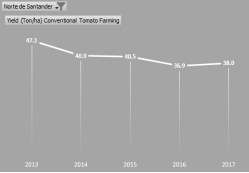

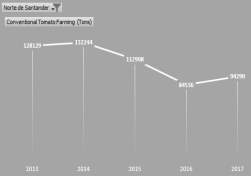
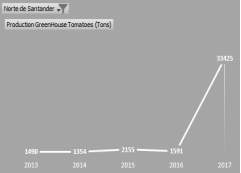
Fig 4. Conventional Tomato Farming and Greenhouse tomatoes (Tons). Source: Calculate from data Agronet 2017
The market for organic tomatoes
As evidenced by the cases reviewed, much still needs to be done in domestic markets to communicate the value and attributes of OA and organic products to consumers. Effective communication of these benefits is necessary so consumers are willing to pay a premium price and retailers can differentiate products in supermarkets and stores. Domestic markets need to be developed in order to reduce the risk of farmers producing solely for export markets and to provide initial local markets for small-scale organic producers (Edwardson & Santacoloma, 2013). In Colombia, studies that try to characterize consumers of organic products are still incipient (Javier Sánchez Castañeda, 2017).
Although, in the area of Catatumbo there are not certified organic tomato reports. In general Organic tomatoes fetch a higher premium price, 10 to 30 percent higher price than conventional tomatoes (Baby, 2013). The price of o organic Chonto tomatoes in Colombia is 153% higher than for conventionally grown fruit (Table 2). The price differential offers a significant incentive for farmers to switch to organic tomato farming.
Table 2. Price Conventional Tomato vs Organic. Source: Compiled from variety of sources[7].
| Price ($ Colombian peso) for Conventional Tomato vs Organic October 2018 per pound | |||
| Variety | Conventional | Organic | Variation |
| Chonto | 1,364 | 3,450 | 153% |
| Long Life | 1,818 | 2,500 | 38% |
| Milano | 2,045 | 2,400 | 17% |
Transition to Organic tomatoes
Important considerations for growing organic tomatoes include variety selection, crop rotation, soil fertility, pest control, weed control and physical conditions of the area.
- The variety selection. Variety selection should be governed by market demand, disease resistance, suitability to climate conditions and production techniques. In Catatumbo the most popular varieties are the tomato de mesa chonto and long life.
- Crop rotation. It is recommended to rotate tomato with non solanacea crops (DANE , 2014). In Catatumbo the cultivation of beans and maize is very common in rotation (CONPES, 2013).
- Soil fertility. It is important to rotate tomato crops with legumes every few years so that the soil is rich in nitrogen. Soil fertility is also boosted by the addition of organic matter and manures (chicken, or bovine compost) are known to boost yields. The compost tea prepared from bovine manure contains soluble nutrients that are readily available to plants (Cano Ríos, et al., 2009). Farmers agree that organic compost and animal manure greatly improve soil fertility (FAO, 2013).
- Pest and weed control. It has observed that organic tomato plants have fewer pest and insect problems than conventionally grown tomato plants. Some studies recommend integrated planting of tomato with sweet corn, which attracts tomato worn (Baby, 2013). Weed control is also important to control diseases. Organic weed control can be achieved using organic matter. Pests, diseases and weed management may be one of the most significant obstacles for transitioning producers and is perceived by conventional producers as the biggest challenge to overcome (Baby, 2013). While solutions exist, growers may not be able to access the resources required to adequately maintain control of weeds and other pests (Serecon Inc. and Groupe AGÉCO , 2018).
- Physical conditions. Physical conditions affect tomato crop yields and it is important to consider both temperature and altitude.The tomato is a fruit which prefers a warm and moderate climate, and is susceptible to frost and low temperatures. It grows in temperatures between 20 to 30 ° C in the day and 15 to 20 ° C in the night, which makes Catatumbo highly suitable for tomato production (CCB, 2015) (CORPOICA, 2013).
Land use. The productive potential of Catatumbo has been repeatedly pointed out by various experts, with agriculture being the mainstay of the rural economy. 14.7% of the area has an agricultural vocation, 1.7% a livestock vocation and 0.4% is suitable for forestry production ( Instituto de Ciencia Política Hernán Echavarría , 2015).
Yields OA is commonly thought to be uncompetitive in terms of yields per hectare (Drinkwater, 1995)yields can drop sharply during the implementation (3 years) but recover once the system is established (Sustainable Agriculture Research & Education, 2012). In economic terms, farmers can fail during this 3 years before certification, because they cannot sell their tomatoes at higher prices during the period when yields usually decrease.
On the other hand, a study conducted in five continents reveals that even thought, the yield decrease, OA is profitable and can be (20-35%) higher than conventional farming (FAO, 1998). Additionally, experiences in India show successful results with double or triple average yields through traditional management. (FAO, 1998). It shows that although is important to know that this difference is very depend on the context and on the local characteristics and well organic management can also make the difference.
Plastic house production. Colombia has started to use greenhouses for tomato production, which makes it easier to control growing conditions. Plastic greenhouses reduce production costs, due to less use of pesticides, and greater efficiency in the use of soil, water and fertilizers (DANE , 2014). The yields under this production system have improved (c. 2 kg/plant in fields compared to 5-8kg/plant in greenhouses so growing organically in greenhouses offers an option to control adverse conditions (DANE , 2014).
Pararell production. Different strategies are used by farmers who want to mitigate the risks of transitioning towards organic production, including the one of split or parallel production. Parallel production allows farmers to transition only part of their operations while continuing to produce crops under a conventional systems in other fields or in other sectors. Doing so enables them to adapt to organic production techniques in one part of their farm without putting their entire operation at risk (Serecon Inc. and Groupe AGÉCO , 2018) However, many individuals are reported to have failed at initial certification attempts because they grew the identical crop both conventionally and organically (Serecon Inc. and Groupe AGÉCO , 2018).
Conclusions and recommendations
Organic agriculture is one of the best ways to provide sustainability. The region of Catatumbo requires sustainable systems that relieve the current conditions.“There is land, aplenty, willing and capable people, and a range of soils and climates that can produce almost any crop, but improving food security requires systems which use available resources sustainably while developing management capacity” (Scialabba, 2007). (FAO, 2013, p. 17)
Organic tomato farming can help to alleviate the severe damage that is causing the overuse of agrochemicals in the conventional agriculture. OA can help to sustain only to the soil, water, air, and biodiversity but also the human health.
The tomato is one of the world’s most important food crops and a particularly important crop for Catatumbo. Globally, organic production is increasing so organic tomato farming offers many opportunities in local[8] and export markets. Organic is becoming more popular because consumers are demanding healthy and environmentally-friendly food.
The initial conversion to organic farming of tomatoes is associated with reduced yields, particularly during the first 3 years of production while soils are adjusting. Even so, the transition to organic farming may be profitable that can help to economy of the area; creating livelihood for the farmers.
Although, Colombia has normative framework for organic agricultural production in place, what it is an advantage, OA systems should be researched and given more support. Lack of information about the local markets, current demands as well as technical information can miscarriage the nascent sector.
It will be important to link the farmers to markets while providing training that reduces the risk of crop failure and helps them to manage quality. Heading in the direction of a robust farming systems to help resource-poor farmers to emerge as commercial producers.
Colombia should learn from the experience of other countries and government should consider promoting OA and creating an enabling environment which encourages the development of organic farming as well as the improvement of the current infrastructure.
Lastly, financial support is very important as financing institutions are encouraged to develop appropriate financing mechanisms, such as subsiding the transition period as well as subsiding or financing the certification cost. They should facilitate the smooth functioning of all essential activities (Edwardson & Santacoloma, 2013).
Bibliography
(n.d.).
Instituto de Ciencia Política Hernán Echavarría . (2015). Una apuesta por la competitividad del Catatumbo. Bogota, Colombia : Instituto de Ciencia Política Hernán Echavarría and Banco de Desarrollo de América Latina.
Adrian Muller, C. S.-H.-H. (2017). Strategies for feeding the world more sustainably with organic agriculture. Nature Communications.
Anna Virginia Adriana Pirozzi, A. S. (2016). Mancozeb, a fungicide routinely used in agriculture, worsens nonalcoholic fatty liver disease in the human HepG2 cell model. Toxicology Letters, 1-4. Retrieved from http://www.sciencedirect.com/science/article/pii/S0378427416300406
Baby, D. (2013). A Study on Organic Tomato Cultivation in Palamedu Panchayat, Madurai District. Global Journal of Science Frontier Research.
Cain, J. (2018, 05 14). Australian Organic Market Report 2018 excites new investment. Australian Food News .
Cano Ríos, P., Márquez Hernández, C., Figueroa Viramontes, U., Preciado Rangel, P., Favela Chávez, E., Ochoa Martínez, E., . . . Moreno Reséndez, A. (2009). Use of Organic Fertilizer in Tomato Production in Greenhouse. Terra latinoamericana.
CCB. (2015). Manual Tomate. BOGOTA: CAMARA DE COMERCIO DE BOGOTA .
CONPES. (2013). Estrategia de Desarrollo Integral de la Región del Catatumbo. Bogotá.: Consejo Nacional de Política Económica y Social. 3739.
CORPOICA. (2013). Tecnología para el cultivo del tomate. Corporación Colombiana de Investigación Agropecuaria,. Retrieved from http://www.siembra.com.co/NetCorpoica/
DANE . (2014). El cultivo del tomate de mesa bajo invernadero, tecnología que ofrece mayor producción, calidad e inocuidad del producto. DANE.
Drinkwater, L. L. (1995). Fundamental Differences Between Conventional and Organic Tomato Agroecosystems in California. Ecological Applications,, 1098-1112. doi:10.2307/2269357
Edwardson, W., & Santacoloma, P. (2013). Organic supply chains for small farmer income generation in developing countries. Rome: FAO.
FAO. (1998). Evaluating the Potential Contribution of Organic Agriculture to Sustainability Goals. Argentina: FAO.
FAO. (2013). Organic Agriculture: African experiences in Resilience and Sustainability . Rome.
FAO. (2018, 10 2). FAO STATISTICS . Retrieved from http://www.fao.org/faostat/en/#data/QC
Fernanda Galgano, R. T. (2016). Conventional and organic foods: A comparison focused on animal products,. Cogent Food & Agriculture,. doi:10.1080/23311932.2016.114
FiBL . (2018, 10 2). Map with key data on organic agriculture (area, organic share, producers, retail sales, and wild collection). Retrieved from FIBL Data Base: https://www.organic-world.net/statistics/maps.html
FIDA . (2003). Agricultura orgánica: una herramienta para el desarrollo rural sostenible y la reducción de la pobreza. Turrialba, Costa Rica: Fondo Internacional de Desarrollo Agrícola (FIDA). Retrieved from http://www.fao.org/3/a-at738s.pdf
Golam Rasul, G. B. (2004). Sustainability of ecological and conventional agricultural systems in Bangladesh: an assessment based on environmental, economic and social perspectives. Agricultural Systems, 327-351.
Gregorio, S. S. (2017). Achieving Sustainable Development Goals Through Organic Agriculture: Empowering Poor Women to Build the Future. Asian Development Bank .
Javier Sánchez Castañeda. (2017). Ecological agricultural products market in Colombia. Suma de Negocios, 8(18), 156-163.
Juárez-Maldonado, A. &. (2015). Análisis de crecimiento del cultivo de tomate en invernadero. Revista Mexicana de Ciencias Agrícolas,, 943-95.
K. Surekha, K. R. (2013). Evaluation of Organic and Conventional Rice Production Systems for their Productivity, Profitability, Grain Quality and Soil Health. Agrotechnology.
Kesavachandran, M. F. (2009). Adverse health effects of pesticides in agrarian populations of developing countries. Reviews of Environmental Contamination and Toxicology, 200, 33-52.
Lernoud, H. W. (2018). Organic Agriculture Worldwide: Key results from the FIBL survey on Organic Agriculture Worldwide . Frick, Switzerland : Research Institute of Organic Agriculture .
Luciana Marques Vieira, M. D. (2013). An analysis of value in an organic food supply chain. British Food Journal, 115 (10), 1454-1472. doi:https://doi.org/10.1108/BFJ-06-2011-0160
Martínez Bernal, L. F., Bello Rodríguez, P. L., & Castellanos Domínguez, Ó. F. (2012). Sostenibilidad y desarrollo : el valor agregado de la agricultura orgánica. Bogotá D.C.: Universidad Nacional de Colombia.
OEA/MAP. (2016). RURAL SETTLEMENT AREA OF ASPASICA, MUNICIPALITY OF LA PLAYA DE BELÉN. Aspacica, Catatumbo: OEA/MAP.
Organic Facts . (2018, 09 21). Impressive Benefits Of Tomatoes. Retrieved from Organic Facts: https://www.organicfacts.net/health-benefits/vegetable/tomatoes.html
Rahmann, G. (2011). Biodiversity and Organic Farming. What do we know? Agriculture and Forestry Research, 189-208. Retrieved from http://www.fao.org/fileadmin/user_upload/suistainability/pdf/11_11_28_OA_biodiversity_Rahmann.pdf
Santos Neto, J. d.-E. (2017). Economic Viability of Tomato Cultivation in Organic Farming System. Brazilian Archives of Biology and Technology.
Scialabba, N. E.-H., & Hattam, C. (2003). Agricultura Orgánica, Ambiente y Seguridad Alimentaria. Rome: FAO.
Serecon Inc. and Groupe AGÉCO . (2018). Transitioning to Organic: A Risk-Based Analysis. Ottawa, ON: Canadian Organic Growers.
Setboonsarng, S. (2006). Organic Agriculture, Poverty Reduction, and the Millennium Development Goals. ASIAN DEVELOPMENT BANK ADB.
Sustainable Agriculture Research & Education. (2012). Organic Systems Make Good Economic Sense. Sustainable Agriculture Research & Education.
Taheri, F. A. (2017). A world without hunger : organic or GM crops? SUSTAINABILITY, 9(4).
Unimedios. (2015). In 20 years Colombia has increased use of pesticides by 360%. Unimedios. Colombian National University.
United Nations. (2015). Transforming our world: the 2030 Agenda for Sustainable Development. Retrieved from sustainabledevelopment.un.org
Uribe, S. P. (2013, November 9). Agroquímicos envenenan suelos en Colombia. Agencia de Noticias Universidad Nacional de Colombia.
Willer, H. a. (2017). The World of Organic Agriculture. Statistics and Emerging Trends 2017. FiBL, Frick, and IFOAM .
Zeynab Jouzi, H. A. (2016). Organic Farming and Small-Scale Farmers: Main Opportunities and Challenges,. Ecological Economics,, 132, 144-154. doi:https://doi.org/10.1016/j.ecolecon.2016.10.016
[1] The Conventional tomato share is 27% while the greenhouse tomato share is 13.7% calculating based on data from (Agronet, Colombia Ministry of Agriculture. (2018, 2 October). [Norte de Santander Tomato Production] [Data Base]. http://www.agronet.gov.co/estadistica/Paginas/default.aspx)
[2] by selling certified organic products in higher prices
[3] Studies show that OA reduces N-surplus and pesticide use needs more land than conventional agriculture (Adrian Muller, 2017)
[4] Developing countries are the leader in small scale organic farming, and developing countries play an important role in food security, even though they are the majority experience food insecurity (Adrian Muller, 2017)
[5] Studies on organic vegetables found that the level of vitamin C was significantly higher in organically rather than conventionally produced plant foods, such as peaches and tomatoes. However, in other studies the vitamin C content in organic and conventionally produced tomatoes, broccoli, bell peppers, and pears was found to be similar (Fernanda Galgano, 2016)
[6] The production of crops in greenhouses is of utmost importance because it gives us an advantage over open-pit production because a barrier is established between the external environment and the crop, creating an internal microclimate that allows the crop to be protected from adverse conditions (wind, hail, pests, etc.) and control factors such as temperature, radiation, CO2 concentration, relative humidity (Juárez-Maldonado, 2015)
[7]*Conventional Tomatoes :https://www.corabastos.com.co/sitio/historicoApp2/reportes/BoletinDescarga.php
*Organic Chonto tomatoes https://arcaikastore.com/verduras-organicas/18-tomate-chonto-organico-x-lb-verduras-organicas.html
*Long life Organic tomatoes: https://encolombia.com/vida-estilo/alimentacion/alimentosorganicos/productos-organicos/
*Milano Tomatoes: http://ecohuerta.com.co/tienda-online
[8] Local research in term of markets niches for organic is needed
Cite This Work
To export a reference to this article please select a referencing stye below:
Related Services
View allRelated Content
All TagsContent relating to: "Farming"
Farming is the business or activity of working on a farm. Farming activities include ground preparations, sowing or planting seeds, tending crops, or activities involved in the raising of animals for meat or milk products.
Related Articles
DMCA / Removal Request
If you are the original writer of this dissertation and no longer wish to have your work published on the UKDiss.com website then please:




